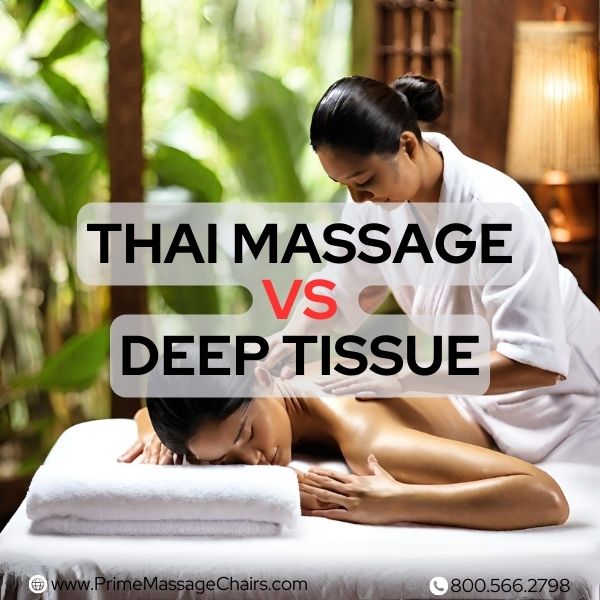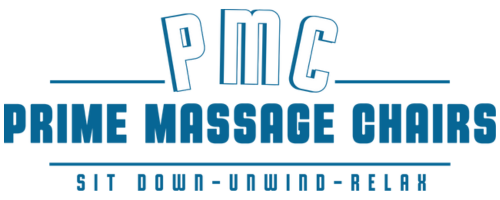
Thai Massage vs Deep Tissue
Thai Massage vs Deep Tissue, which is right for you? Deciding can be tricky if you're not sure what your body needs.
Both offer unique ways to ease muscle tension and improve overall well-being.
Our guide will explain the differences and benefits of each, helping you make the best choice for your relaxation or healing journey.
Now let's discuss the details.
Understanding Thai Massage
Dive into the dynamic world of Thai massage, a unique blend of acupressure and stretching that promises to enhance your flexibility and invigorate your body.

Embrace this traditional therapy often dubbed the 'lazy man's yoga,' as it guides you towards a deeper level of physical well-being.
Benefits of Thai Massage
Thai massage is more than just kneading muscles. It combines stretching and pressure to enhance wellness.
- Improves flexibility: With its yoga-like stretches, Thai massage helps increase your range of motion, making it easier for you to move.
- Boosts energy flow: The techniques used in Thai massage aim to enhance relaxation and well-being, potentially influencing perceived energy levels.
- Relaxes whole body: Gentle rocking and pressure applied during a Thai massage provide a deep level of relaxation.
- Helps with pain: If you have tight muscles or stiffness, Thai massage can ease your discomfort.
- Spiritual uplift: The traditional aspects of Thai massage may contribute to a sense of mental and spiritual refreshment for some individuals, acknowledging that experiences can vary.
- Good for stiff muscles: Those who feel tight all over will find the stretching exercises especially beneficial.
- Increases circulation: As the masseuse works on your body, blood flow improves, which can speed up healing.
- No need to undress: You wear comfortable clothing throughout the session, which makes it convenient and less stressful for many people.

Drawbacks of Thai Massage
Thai massages offer unique benefits, but there are also some drawbacks to consider. If you have very tight muscles or lots of scar tissue, you might find this massage less comfortable.
- Oil and cream use: Some people enjoy the feel of oils or creams during a massage. Traditional Thai massage does not typically include the use of oils or creams, which might be a consideration for those who prefer their inclusion during a massage.
- Muscle tightness: The stretching involved in Thai massage might be challenging for individuals with extremely tight muscles, and it's advisable to approach it with caution. This can lead to discomfort during the session.
- Scar tissue sensitivity: If you have a lot of scar tissue or bruises, you may find that Thai massage makes it hard for therapists to work around these areas without causing pain.
- Risk of injury: Because Thai massage involves active movement, there's a small chance you could get hurt if not done properly by a trained professional.
- Slow results: Unlike some other types of massages, the effects of Thai massage might take longer to become apparent.
- Intimacy considerations: The close contact required in Thai massage may cause discomfort for those who aren't used to such proximity with their therapist.
Understanding Deep Tissue Massage
Delving into deep tissue massage reveals a therapeutic practice that targets the deeper layers of muscle and connective tissue, often employed to address chronic pain and lingering sports injuries.

This intense form of massage therapy can provide profound healing, reaching areas untouched by more superficial techniques.
Advantages of Deep Tissue Massage
Deep tissue massage is a powerful tool for healing and relaxation. It targets the deeper layers of muscle and connective tissue to ease pain and restore movement.
- Deep tissue massage applies firm pressure targeting deeper muscle layers, which may help some individuals in loosening perceived muscle tightness and alleviating discomfort, though responses can vary.
- The technique is believed to potentially improve blood flow in the body, though individual experiences may differ. Better circulation brings more oxygen and nutrients to sore areas, speeding up recovery.
- Athletes often get deep tissue massages. The strokes help with sports injuries by reducing inflammation and aiding in rehabilitation.
- Massage therapists use slow movements and direct pressure in deep tissue massage. These methods address issues like chronic back pain, tendonitis, and osteoarthritis.
- deep tissue work may contribute to reductions in stress hormone levels and improvements in mood, though effects can vary between individuals. This change can lessen anxiety and improve your mood.
- Sessions provide relief from tension headaches. By focusing on head, neck, and shoulder tensions, deep tissue massage relieves headache-causing strain.
- Such massages may decrease the need for painkillers. By managing muscle pain effectively, you might find less need for medication.
Potential Cons of Deep Tissue Massage
Deep tissue massage targets the deeper layers of muscle and connective tissue. It uses strong pressure and can help with chronic muscle pain.
- Deep tissue massage can be intense and may cause discomfort for some individuals, but communication with the therapist can help manage this. It should not cause extreme pain or a nervous system reaction.
- People who want a gentler touch might not enjoy the firm pressure. This massage goes past the superficial skin layers to reach deep muscles.
- Folks who deal with pain often may find deep tissue massage too intense. The heavy pressure used in deep tissue massage may not be suitable for everyone, especially those with certain pain conditions, and it's important to consult a professional beforehand.
- If you have fresh injuries like broken bones, steer clear of this massage. It's also not suitable for anyone with open wounds.
- While rare, it's important to note that the intense techniques used in deep tissue massage can lead to discomfort or soreness, particularly if not performed by an experienced therapist.
- The effects might come on slowly after this type of treatment. You won't always feel better right away.
- Deep tissue sessions can bring up feelings of vulnerability due to the intense physical contact needed.
Comparing Thai Massage and Deep Tissue Massage
When deciding between Thai massage and deep tissue massage, it's important to understand how they differ in their approach to muscle and body work.

Thai Massage:
- Techniques Used: Stretching, pulling, rocking, and pressure along energy lines.
- Focus: Overall body alignment, flexibility, and energy balance.
- Clothing: Performed with the client wearing loose clothing.
- Intensity: Can be gentle or firm, depending on practitioner and client's preference.
- Best For: People looking to improve flexibility and relieve mild to moderate tension.
- Not Ideal For: Those with acute injuries, severe pain, or dislike of stretching.
Deep Tissue Massage:
- Techniques Used: Slow, concentrated pressure on targeted areas.
- Focus: Specific muscle groups, chronic pain, and tension relief.
- Clothing: Client often undresses to a comfortable level with draping.
- Intensity: Usually involves firm to intense pressure.
- Best For: Individuals with deep-seated chronic aches, muscle tightness, and tension.
- Not Ideal For: People with very tight muscles, acute injuries, or sensitivity to firm pressure.
Thai massage offers a unique experience with its emphasis on stretching and energy lines, while deep tissue massage targets deeper layers of muscle and is best for chronic issues.
FAQs
What is the difference between Thai massage and deep tissue massage?
Thai massage, known as lazy man's yoga, uses stretching and pressure on muscles through a full-body routine for relaxation and flexibility. Deep tissue massage focuses on realigning deeper layers of muscles and fascia to relieve pain.
Can both Thai massage and deep tissue help with pain relief?
Yes, both types of massages can help reduce pain. Thai massage relieves stress and improves sleep while deep tissue targets chronic pains like low back pain by breaking down adhesions.
Are Swedish massages the same as these two therapies?
No, Swedish massages are more about gentle relaxation while Thai massages include more movement, and deep tissue works deeper into muscles for specific issues like repetitive strain injuries or sports injuries.
Who should get a deep tissue or a Thai yoga massage?
Deep tissue is good for people with musculoskeletal problems or carpal tunnel syndrome because it reaches tendons that are tight from injury or stress. People looking for overall physical health benefits might prefer the fluid movements of a Thai yoga massage.
What's special about how they give these kinds of massages?
In Thai massages, therapists use their elbows, hands, knees to move you around. Deep tissues involve using direct pressure to work out tension in targeted areas promoting collagen fibers realignment.
Conclusion
When thinking about Thai massage vs deep tissue, consider what your body needs.
It's also important to consult with your doctor before starting any new massage activities, especially if you have pre-existing medical conditions.
Thai massage aligns energy and boosts flexibility through stretches. Deep tissue targets muscle knots for serious pain relief.
Think about comfort, either staying clothed or using oils on skin. Your preference guides you to the best healing touch for your wellness journey.
Disclaimer:
We do not provide medical advice. The content of this article, including text, graphics, and other material, is for informational purposes only. It is not intended to be a substitute for professional medical advice, diagnosis, or treatment. Always seek the advice of your physician or other qualified health provider with any questions you may have regarding a health condition. Never disregard professional medical advice or delay in seeking it because of something you have read in this article or on our website.
